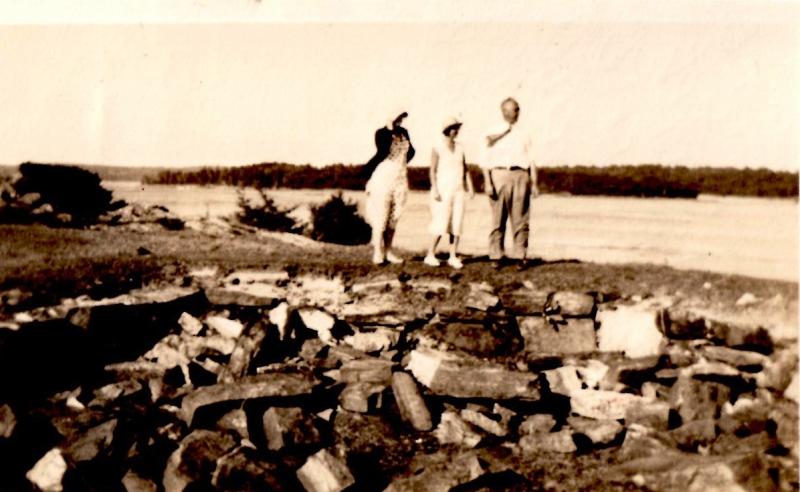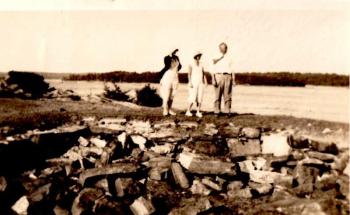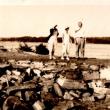Boothbay in the War of 1812
Elizabeth Reed, born 1874, was a local historian of the 1940s and 1950s. She was a native, though she was gone for decades teaching in New York City before retiring to Boothbay Harbor. All the parenthetical remarks are mine. - Barbara Rumsey
Our War of 1812 was a part of the Napoleonic Wars and our trouble with England ended when Napoleon was defeated at Waterloo in 1815. Boothbay seamen and ship owners suffered severely because of the British Acts in Council and Napoleon’s decrees. Britain impressed American seamen because she just had to have sailors to man her navy in order to prevent Napoleon’s landing an army in England. One Boothbay man, David Reed, died in Dartmoor prison in England after having been impressed.
Boothbay was absolutely without defenses when war was declared June 18, 1812. On June 7 a town meeting was held in Boothbay to "take into consideration the alarming and defenseless situation of the town’s inhabitants . . ." A petition for protection was sent to President Madison signed by a committee consisting of Joshua Loring, Edmund Wilson, Nicholas Knight, John McClintock, and Jacob Auld. To these names were added Samuel Thompson, Henry Kimball, Nathaniel Montgomery, and Joseph Grimes, and it was voted that these men be a standing Committee of Safety for the town. William M. Reed quickly obtained cannon, ammunition, and bullet molds and fortifications were erected.
Local Forts
The sites for the earthworks and cannon mounts were at McFarland’s Point, Wylie Point (where St. Andrews is) and on the heights beyond West Harbor Dam (near Powder Hill Farm on Lakeside Drive). As during the Revolution, Boothbay shipping was hidden in Campbell’s Cove, now West Harbor Pond. A gun house was built on what is now Eastern Avenue and near it was the training field as it was used during the Revolution. (The gun house, once owned by Chester Holton and later by Jane and Ervin Conley, is now on Montgomery Road}.
Within my memory the 1812 earthworks on McFarland’s Point and on Wylie Point were plainly visible and as a child (she was born in 1874) I played around them. The Bacchus cottage on McFarland’s Point (on Eames Road) leveled off the fortifications there. (Pearl Patten Mautner who witnessed the building of the cottage says the earthworks were built upon, not leveled, and any grading was very slight). The Gregory Hospital and Gregory House leveled off the earthworks on Wylie Point.
Guarding the entrance to the Damariscotta River was Fort Farley on Fort Island at Back Narrows just above East Boothbay. Fort Farley was a blockhouse just like the one on Davis Island only a little smaller. It stood there in a good state of preservation nearly down to the time of the Civil War. My late uncle John H. Blair, born in 1842, remembered it well. He said the people of Back Narrows tore it down for firewood, the more the pity. The brick foundation is still in good condition in its original octagonal form. The writer has visited the spot on several occasions and from there is a fine view of the open ocean.
Local British Harassment
While there was a constant watch, yet the Boothbay companies of Jacob Auld and Daniel Rose were only called out on alarm when British men-of-war, the Bulwark, the Tenedos, and others appeared in the Harbor. The British cruisers Rattler, Bream, and Bulwark anchored in Boothbay Harbor on numerous occasions. They sometimes stayed days at a time capturing lumber-laden schooners; one such schooner, which had been captured, was recaptured and safely hidden in Campbell’s Cove.
The most dangerous and anxious time for Boothbay was during the months of June, July, and September of 1814 when British cruisers constantly landed bargeloads of men on both sides of Spruce Point and on the Sheepscot River shores of the town only to be driven off by our local militia. William M. Reed’s company of militia drove them off every time. Once the British landed right in front of his Boothbay House (on the present site of Boothbay House Hill Road) and was driven off by his company. Other local companies besides the three already mentioned were those commanded by David Reed Adams, William McCobb, and Samuel G. Wilson.
It is not known how many men were captured by the British and were in captivity in British prisons or at Ottawa, or how many died there of starvation and neglect. Two Boothbay men, Thomas Boyd and George Kelloch, were killed in the Battle of Plattsburg Bay and the Battle of Lake Champlain in January of 1814. In 1814 John Grover’s son was killed just outside the old Allen Lewis house on the eastern slope of Mt. Pisgah when British marines landed there, but they were soon driven off.
After one year of humiliating defeats on land, Madison begged the British government for peace and on December 24, 1814, a treaty was signed at Ghent in which nothing was said about the four causes for which Madison asked Congress to declare war against Great Britain.
Event Date
Address
United States
























